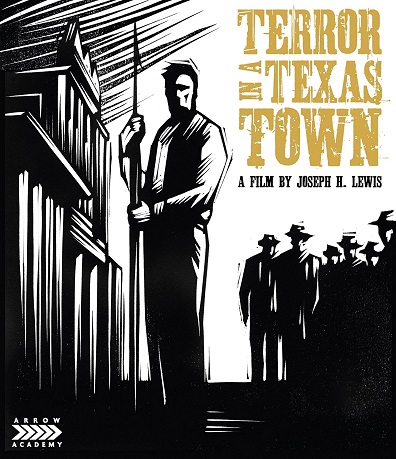
Terror in a Texas Town
Studio: Arrow Academy
Jul 27, 2017
Web Exclusive
![]()
Released in 1958, Terror in a Texas Town feels simultaneously ahead of and behind the times. It’s lurid – and frankly misleading – title and the iconic image of Sterling Hayden facing down a gunslinger armed only with a whaling harpoon all presage the gimmick-driven grindhouse era of the 1970s. But its B-movie aesthetic and noir-inspired black-and-white cinematography feel like a throwback, especially in an era when most Westerns opted for widescreen Technicolor vistas and sweeping spectacle. It tells one of the oldest stories in the Western playbook: a wealthy hotel owner wants to buy up the surrounding farms when the locals strike oil. He hires a ruthless gunslinger to terrorize them into selling. The only man capable of stopping them is an outsider who blows into town looking for revenge. The plot is narrative bedrock, but the way in which the story is told makes all the difference.
Terror in a Texas Town was the final film by Joseph H. Lewis, a B-movie director with two decades of work under his belt. Although Lewis was never elevated to the ranks of the great auteurs, several of his films were stylish enough to remain popular with film buffs more than half a century later. His two best remembered films are the 1955 noir, The Big Combo and the 1950 film Gun Crazy, a nasty little precursor to Bonnie and Clyde. The latter film features the offbeat characterization and dynamic camera work that make Terror in a Texas Town such an odd little gem.
There’s quite a bit about the film that doesn’t or shouldn’t work. The hero, played by iconic tough guy Sterling Hayden, is a Swedish immigrant with a distaste for violence and an accent that occasionally veers into Irish. The film takes place almost entirely in cramped indoor spaces, foregoing the rugged landscape shots that define the genre. And yet something about the grim, noir sensibility Lewis brings to the filmmaking makes it striking and compelling at every turn. Credit should also go to screenwriter Dalton Trumbo, a frequent Lewis collaborator, who brings his experiences with the blacklist to bear via capitalist villains who bully and brutalize the local farmers until they start to turn on each other.
The MVP of the film is actor Nedrick Young as Johnny Crale, the black-clad gunman hired to murder anyone who won’t sell their land or inform on their neighbors. Crale feels like something out of a comic book with his dark outfit, twin revolvers and steel hand replacing one lost in a gunfight. It all sounds quite over the top, but Young – another blacklisted screenwriter who turned to acting – gives him a sad weariness that makes him arguably more compelling that Hayden’s upright hero. The opening scenes, in which Crale accepts the job to terrorize the town against the wishes of his equally weary girlfriend, seem like they’re setting him up to be the protagonist of the film. Crale is about as far from heroic as it gets, but Young imbues him with the air of a man who regrets what he’s become but doesn’t have the means or desire to be anything else.
Arrow’s new 2K restoration of Terror in a Texas Town does wonders for the film’s low-rent aesthetic and Lewis’s excellent use of depth of field. It also includes an introduction and visual essay by author Peter Stanfield. Combined they run about a half hour and do an excellent job of exploring the film’s style, its production history and Lewis’s modest position in the pantheon of mid-20th century auteurs.
Current Issue

Issue #72
Apr 19, 2024 Issue #72 - The ‘90s Issue with The Cardigans and Thurston Moore
Most Recent
- Under the Radar Announces The ’90s Issue with The Cardigans and Thurston Moore on the Covers (News) — The Cardigans, Thurston Moore, Sonic Youth, Garbage, The Cranberries, Pavement, Lisa Loeb, Supergrass, Spiritualized, Lush, Miki Berenyi, Miki Berenyi Trio, Emma Anderson, Hatchie, Ride, Slowdive, Velocity Girl, Penelope Spheeris, Terry Gilliam, Gus Van Sant, Ron Underwood, Kula Shaker, Salad, Foals, Semisonic, The Boo Radleys, Stereo MC’s, Pale Saints, Blonde Redhead, Sleater-Kinney, Cocteau Twins, Lucy Dacus, Alex Lahey, Horsegirl, Grandaddy, alt-J, Squid, The Natvral, Wolf Alice, Jess Williamson, Sunflower Bean, Orville Peck, Joel McHale
- Fresh Shares New EP ‘Merch Girl’ (News) — Fresh
- Premiere: LOVECOLOR Shares New Video for “Crazy Love” (News) — LOVECOLOR
- Final Summer (Review) — Cloud Nothings
- Tallinn Music Week, Tallinn, Estonia, April 3-7, 2024 (Review) — Virta, Musta Huone, Mari Kalkun, Sven Grünberg

Comments
Submit your comment
There are no comments for this entry yet.